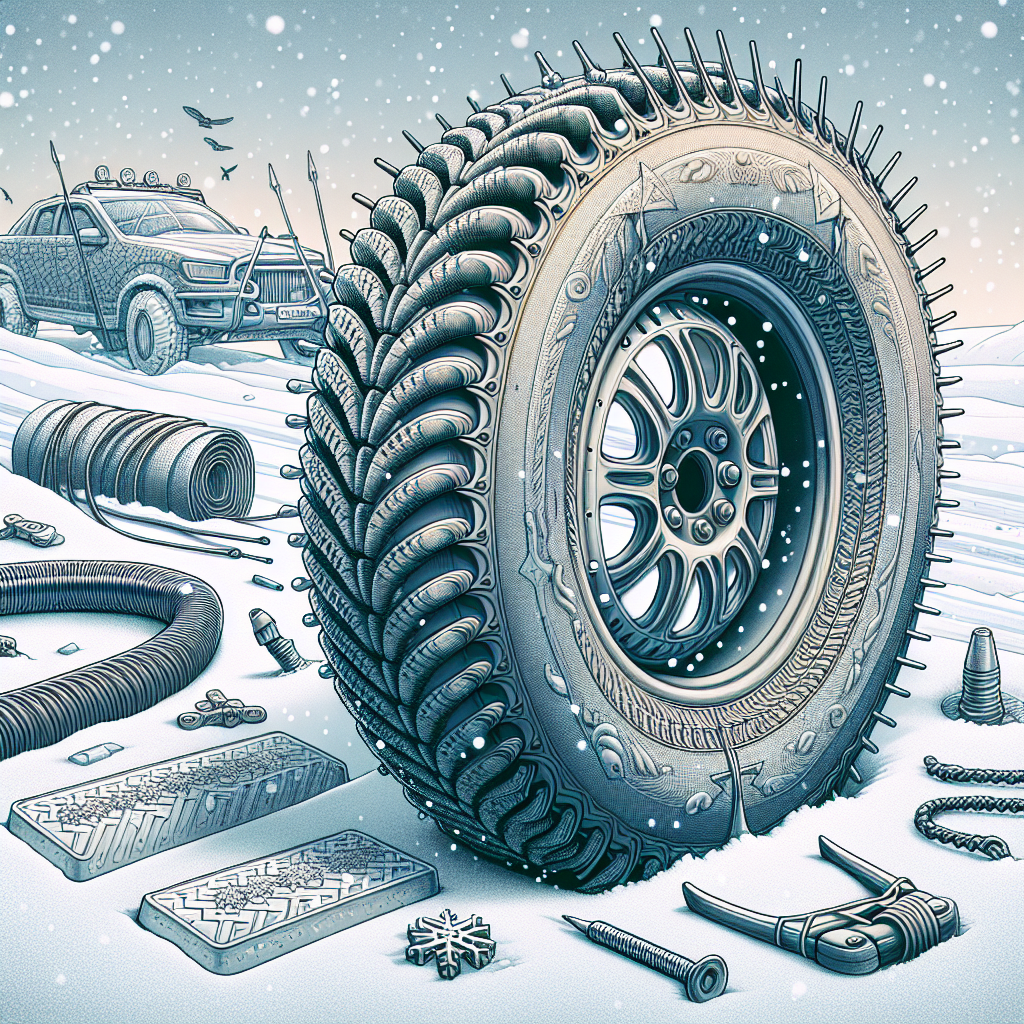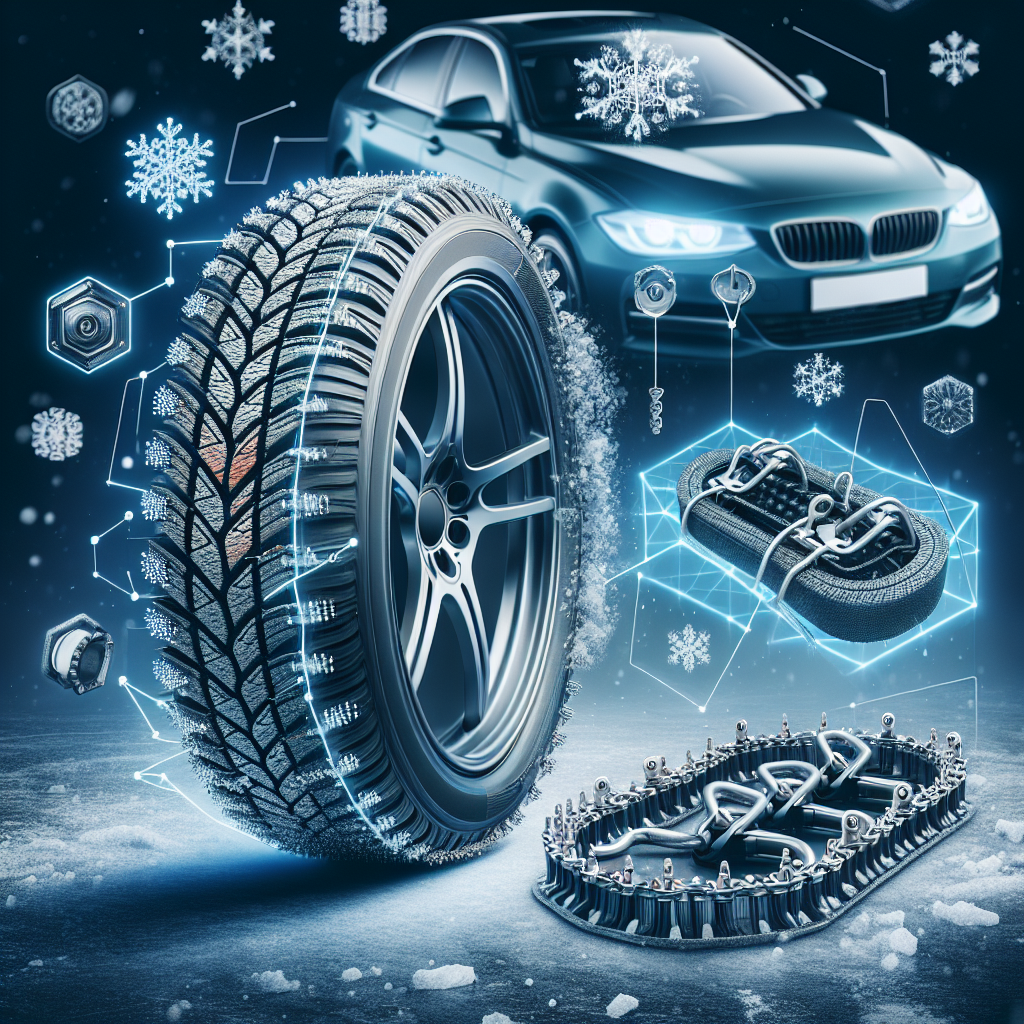When it comes to icy conditions, safety is paramount. And one crucial aspect of ensuring safety while driving on icy roads is having the right tires. Studded winter tires have long been the go-to solution for many drivers, offering excellent traction and control. But have you ever wondered if there are alternative options? In this article, we explore whether there are alternatives to studded winter tires that can offer similar performance on icy roads. So buckle up and let’s find out!
1. Non-Studded Winter Tires
1.1 Winter Tire Technology
When it comes to navigating icy conditions, non-studded winter tires can be a reliable alternative to studded tires. These specialized tires are designed with unique features that enhance their performance in snowy and icy conditions. Non-studded winter tires are made from a softer rubber compound, which allows them to maintain flexibility even in cold temperatures. This flexibility enables the tires to grip the road surface effectively, providing better traction and control.
1.2 Traction Control and Grip
One of the key advantages of non-studded winter tires is their excellent traction control and grip on icy surfaces. The tread patterns on these tires are specifically designed to bite into the snow and ice, creating channels for water dispersion. This helps reduce the risk of hydroplaning and enhances the tire’s ability to maintain contact with the road. Additionally, the presence of sipes, which are small slits on the tire surface, further enhance grip by increasing the number of edges in contact with the road.
1.3 Winter Tire Categories
Non-studded winter tires come in various categories, each tailored to specific winter driving conditions. The three main categories are:
-
Performance Winter Tires: These tires are designed for vehicles that require heightened handling capabilities in winter. They offer improved cornering stability and braking performance, making them ideal for sports cars and high-performance vehicles.
-
Studless Ice & Snow Tires: This category is popular among drivers looking for outstanding traction in icy conditions. These tires utilize advanced rubber compounds and tread designs specifically engineered for icy surfaces, offering maximum grip and control.
-
Studless Winter Tires: These tires are designed with a focus on overall winter performance in a variety of conditions. With a balance of snow traction and wet-weather handling, they are suitable for areas with fluctuating winter weather.
2. All-Season Tires
2.1 Performance in Icy Conditions
While all-season tires may be a reliable choice for year-round use, they may not perform as well in icy conditions compared to non-studded winter tires. All-season tires are designed to provide a decent balance between dry and wet traction, as well as light snow conditions. However, their performance on ice can be subpar, as they lack the specialized features that make non-studded winter tires excel in such conditions.
2.2 Differences from Winter Tires
When it comes to icy conditions, all-season tires have a few key differences from winter tires. All-season tires generally have a harder rubber compound, which helps them last longer in varying temperatures but can reduce their performance on ice. Additionally, the tread patterns of all-season tires are not specifically designed to bite into ice and provide the same level of grip as non-studded winter tires. Therefore, while all-season tires can be a versatile option for year-round driving, they may not be the most effective choice for navigating icy conditions.

3. Snow Chains
3.1 How Snow Chains Work
Snow chains are another alternative for increased traction in icy conditions. These chains are made of metal and are designed to wrap around the tire, providing additional grip on snow and ice-covered roads. Snow chains work by increasing the surface area of the tire in contact with the road, which helps minimize slippage and enhances traction. With their sturdy metal construction, snow chains can dig into icy surfaces and provide reliable traction for safe driving.
3.2 Installation and Usage
Installing snow chains can be a bit challenging, especially for first-time users. However, with a little practice and following the manufacturer’s instructions, installation becomes easier over time. It’s crucial to ensure that the chains are correctly fitted and secure to prevent them from coming loose while driving. Additionally, it’s important to note that snow chains should only be used on icy or snowy roads. Otherwise, they can cause damage to the road surface and decrease traction on regular asphalt or concrete.
3.3 Limitations of Snow Chains
While snow chains can significantly improve traction on icy surfaces, they do have some limitations. Firstly, driving with snow chains at higher speeds is not recommended as it can cause excessive wear on the tire and the chains themselves. Additionally, snow chains can create a noisy and bumpy driving experience. Moreover, it’s essential to be cautious while driving with snow chains as sudden maneuvers or excessive acceleration can lead to loss of control. Finally, removing and storing the chains when they are not needed can be inconvenient and time-consuming.
4. Tire Socks
4.1 Description and Functionality
Tire socks, also known as snow socks or tire chains socks, are fabric-based covers that slip over the tire to provide additional traction on icy surfaces. These socks are made from a high-strength textile material, reinforced with rubber or metal studs that bite into the ice and snow, enhancing grip. The fabric’s design allows it to conform to the tire’s shape, ensuring a secure fit.
4.2 Installation and Usage
Installing tire socks is relatively simple. They can be easily slipped over the tire and secured using adjustable straps or elastic bands. Unlike traditional snow chains, tire socks are lightweight and compact, making them easy to store and handle. It’s important to note that tire socks are typically designed for temporary use and are not intended for extended high-speed driving or on dry road surfaces. Once the icy conditions subside, it is recommended to remove the tire socks to prevent unnecessary wear and tear.
4.3 Effectiveness on Icy Surfaces
Tire socks provide a good amount of traction on icy surfaces, making them a viable alternative to studded tires. The rubber or metal studs embedded in the fabric increase the tire’s grip, providing better control and maneuverability on slippery roads. While they may not offer the same level of traction as traditional snow chains or studless winter tires, tire socks are a convenient option for those who want a lightweight and portable solution for occasional icy driving conditions.

5. Tire Stud Alternatives
5.1 Traction Studs
Traction studs are small metal studs that can be screwed into the tire’s tread to provide enhanced grip on ice and hard-packed snow. These studs are typically made of durable materials like tungsten carbide, which ensures their longevity. Traction studs work similarly to traditional studded tires by breaking through the icy surface and creating additional friction points, improving traction.
5.2 Traction Bands
Traction bands, also known as grip bands or snow grip socks, are circular bands made of strong elastic material that wrap around the tire’s tread. These bands have metal or rubber spikes evenly distributed around their circumference, allowing them to dig into the ice and provide added grip. Traction bands are easy to install and remove, making them a convenient option for occasional icy conditions.
5.3 Rubber Studs
Rubber studs are small, rubberized spikes that can be inserted into the tire’s tread. These studs work by enhancing grip on icy surfaces without causing damage to road surfaces. Rubber studs are lightweight and easy to install, making them a practical alternative for temporary icy conditions. However, it’s important to note that rubber studs may wear down faster than metal studs and may not provide the same level of traction in extremely icy conditions.
6. Improving Winter Tires’ Performance
6.1 Proper Tire Inflation
Maintaining proper tire inflation is crucial for enhancing the performance of winter tires, regardless of whether they are studded or non-studded. Cold weather can cause tire pressure to drop, reducing traction and stability. Regularly check the tire pressure and keep it at the recommended levels specified by the vehicle manufacturer. This ensures that the tire maintains optimal contact with the road surface, maximizing grip and handling.
6.2 Regular Tire Maintenance
Winter tires, like any other type of tires, require regular maintenance to ensure their optimal performance. It’s important to regularly inspect the tires for any signs of wear, such as uneven tread wear or punctures. Rotate the tires regularly to promote even wear and replace them when the tread depth reaches the recommended minimum. Additionally, maintaining proper wheel alignment and balancing can also have a positive impact on the tire’s performance in icy conditions.
6.3 Driving Techniques for Icy Conditions
Even with the best winter tires, proper driving techniques are essential for safe navigation in icy conditions. Always drive at a safe speed and maintain a safe distance from the vehicle in front to allow for ample stopping distance. Avoid sudden acceleration, braking, or steering maneuvers, as they can cause the tires to lose traction. Instead, drive smoothly, and if necessary, use gentle inputs on the throttle, brakes, and steering while maintaining a consistent and predictable driving style.

7. The Importance of Winter Tires
7.1 Increased Safety
Winter tires, whether studded or non-studded, play a crucial role in enhancing safety during icy conditions. The specialized design and features of these tires significantly improve traction and control, reducing the risk of accidents and skidding. By providing better grip on snow and ice-covered roads, winter tires allow for more confident and controlled driving, making them an essential investment for anyone living or driving in areas with cold climates.
7.2 Legal Requirements
In many countries and regions, the use of winter tires is legally mandated during specific months or when specific weather conditions are present. These laws are in place to ensure the safety of drivers and reduce the risk of accidents caused by inadequate tire performance in winter conditions. It is important to be aware of the legal requirements in your area and adhere to them to avoid potential fines or penalties.
7.3 Insurance Considerations
Using appropriate winter tires can also have an impact on insurance coverage in the event of an accident. Some insurance policies may require the use of winter tires during specific months or in certain weather conditions to be eligible for coverage. By complying with these requirements, drivers can ensure that they are fully protected in case of an accident during winter driving conditions.
8. Considerations for Choosing an Alternative
8.1 Climate and Road Conditions
When considering alternatives to studded winter tires, it’s important to assess the specific climate and road conditions in the area where you will be driving. If you regularly encounter icy or snowy conditions, non-studded winter tires, snow chains, or other traction-enhancing options may be the most suitable choice. However, if your area experiences occasional light snow or only cold temperatures without substantial snow or ice, all-season tires may provide sufficient performance.
8.2 Vehicle Type and Usage
The type of vehicle you own and the way you use it should also be taken into account when choosing an alternative to studded winter tires. Performance-oriented vehicles or those used for off-road purposes may require non-studded winter tires with specific characteristics that cater to their unique needs. On the other hand, daily commuters or urban drivers may find tire socks or other lightweight alternatives more practical and convenient.
8.3 Budget Constraints
Budget considerations can also influence the choice of an alternative to studded winter tires. Non-studded winter tires, snow chains, or other specialized options can be more expensive upfront compared to all-season tires. However, it’s important to consider the long-term savings in terms of safety and maintenance costs. Investing in high-quality winter tires or suitable alternatives can prevent accidents, minimize vehicle damage, and provide peace of mind during winter driving.

9. Recommendations from Experts
9.1 Tips and Advice
Experts recommend several key tips and advice when it comes to navigating icy conditions without studded winter tires. These include:
- Checking weather forecasts and planning your trips accordingly
- Allowing for extra travel time to ensure a slower and safer pace
- Keeping a winter emergency kit in your vehicle, including essentials like a shovel, ice scraper, jumper cables, and a flashlight
- Practicing defensive driving techniques and being prepared for sudden changes in road conditions
- Seeking professional advice from tire experts or mechanics to determine the best alternative for your specific needs
9.2 Evaluation of Alternatives
Experts often recommend evaluating the specific alternatives available in the market to choose the most suitable option. Factors to consider during the evaluation include traction on ice, ease of installation and removal, durability, noise level, and compatibility with your vehicle’s tire size and type. Reviews and recommendations from reputable sources or experienced drivers can also provide valuable insights during the evaluation process.
9.3 Importance of Professional Advice
It’s important to consult with tire professionals or knowledgeable individuals in the automotive industry to ensure you make an informed decision. They can provide personalized recommendations based on factors such as your vehicle type, driving habits, and local climate conditions. Seeking expert advice can help you select the most appropriate alternative to studded winter tires that meets your specific requirements and provides optimal performance.
10. Conclusion
10.1 Summary of Alternatives
In conclusion, several alternatives to studded winter tires are available for navigating icy conditions. Non-studded winter tires, such as performance winter tires and studless ice & snow tires, offer excellent traction control and grip on icy surfaces. Snow chains, tire socks, traction studs, and traction bands are other viable options for enhanced traction. Each alternative has its own advantages, disadvantages, and suitability based on factors like climate, road conditions, vehicle type, and budget.
10.2 Considerations for Decision-making
When deciding on the most suitable alternative, it is important to consider factors such as climate and road conditions, vehicle type and usage, and budget constraints. Additionally, proper tire maintenance, driving techniques, and adherence to legal requirements and insurance considerations must be taken into account to ensure safety and compliance. Seeking recommendations from experts and evaluating the available alternatives based on their specific features and performance can assist in making an informed decision.
Ultimately, by selecting the right alternative to studded winter tires and following recommended practices, you can ensure a safe and confident driving experience during icy conditions, providing peace of mind and enhancing overall road safety.


